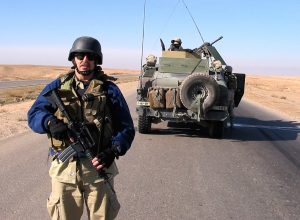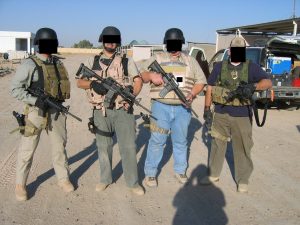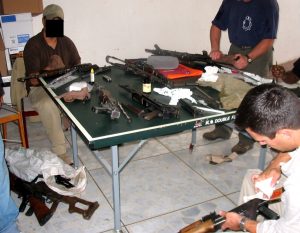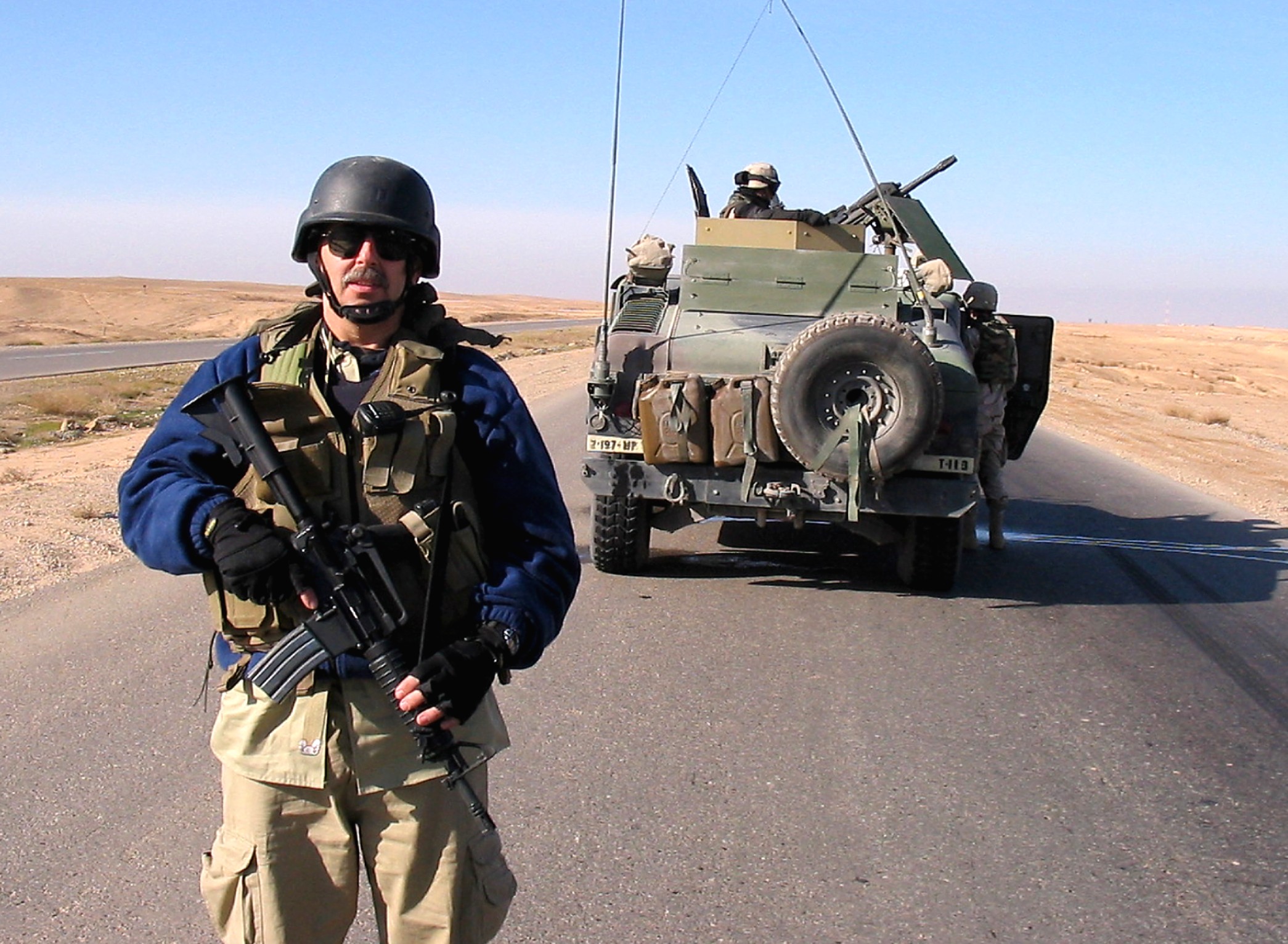
I’ve spent the past 14 years traveling in and out of various conflict zones in Africa and the Middle East, and two and a half of those years were spent deployed in Iraq. From August 2004 through April 2007 I worked as a private security contractor, as a Personal Security Detail (PSD) team member and tactical driver, a convoy escort vehicle commander, the overall security team leader for $500 million in Department of Defense (DoD) reconstruction projects throughout Iraq, and finally as the security manager and force commander at a remote project site isolated in the Mahdi Militia region of southern Iraq. Each of those positions required me to be armed every day and gave me the honor of working with a lot of great people from the USA, Great Britain, South Africa, Nepal, Philippines, Angola, Iraq, Lebanon, Kurdistan and some other places that slip my mind right now. It also gave me the opportunity to carry and use a wide range of military weapons.

If we wanted to discuss the small arms issued to any given nation’s armed forces, it would be a fairly straightforward process. The US troops carried M16s or M4 Carbines, M203s, SAWs, M240s, and Beretta M9 pistols. Troops from the former Soviet Bloc nations such as Romania and Georgia were issued variants of the venerable AK47, or more commonly the AKM, along with RPKs and PKMs. The British carried SA80s and L85s, and the Australians (who I worked closely with in Nasiriyah) carried F88 AUsteyr’s. The special ops teams of almost all the Western armies used the M4.
On the other hand, independent security contractors (branded mercenaries by some) carry whatever they’re issued by their employers. I’ve seen guys carrying everything from ancient British Sterling subguns to state of the art P90s. We can all sit in the comfort of our homes behind our keyboards and argue about what handgun is the best for us to EDC, or debate about the AK vs the M4, but when you are a security contractor in a war zone you make the best of whatever you’re issued by your employer.
Arming on the Cheap
Back in the Wild West days of Iraq, the quickest and cheapest way to arm a private security force was to simply hand someone you trust a duffle bag full of cash and send them out into the unsecured areas to buy some guns and ammo on the Black Market. Guns procured this way had usually been ‘liberated’ from the Iraqi military in one way or another, and were generally well broken in, to put it mildly. The weapons I’ve seen acquired this way include AK variants, HK G3s, MP5s, FNs, Browning Hi-Powers, and even the aforementioned Sterling and using them on a daily basis can be an adventure in itself! A month after arriving in Iraq our Suburban crashed on Route 1 near the Samara Overpass. The guy next to me was carrying a locked and loaded Sterling. The Sterling is an open bolt design not known for its safety, and as we bounced off a large local truck and crashed through the guardrails, I recall hoping the guy next to me was pointing that damned Sterling somewhere besides my direction as all our footlockers were flung forward hitting him square in the face (he was facing backwards at the time of the crash). He survived with a concussion and I didn’t get shot, so I put that one in the win column. I was very happy that on my last major DoD contract I was issued a shiny new Colt M4 and a nice Kimber 1911.
The Guns of Iraq Contractors
As I mentioned previously, the guns used daily by private security teams in Iraq ran across a wide spectrum of weapons. Probably the easiest way to cover them all is to break them down by origin.

- Russian/former Soviet Bloc weapons– These were by far the most common type of weapon used in Iraq. Obviously, both the Iraqi security forces and the insurgents/terrorists used them, but they were also used by the vast majority of all static guard forces no matter what nationality they were. They were also used by more than half of the PSD and convoy escort teams made up of foreign (expat) contractors. They were common and easily available, cheap to purchase, and ammunition was readily available from both legitimate and illegitimate sources. On the downside, many were older and well used, so they required a considerable amount of attention and care to ensure they would work when you needed them to. These were mostly the AKM version of the AK47, some with folding stocks and others with solid wood stocks. A few even had the old integral wooden forearm grip. One also saw the occasional Dragunov sniper variant, as well as lots of locally made copies.
- US Manufacture– Roughly a third of the private security contractors were issued US made rifles, as were a very small number of non-Western static guard forces. For the most part, these consisted of M16/M4 rifles and carbines. Some contractors on direct military support contracts were issued actual US Army weapons, but most companies were responsible to procure their own guns to issue their contractors. Most of these were collapsible stock models because we normally operated from vehicles, and in my time there I was issued a Bushmaster Short Barreled Rifle (SBR) and later the Colt M4. Everyone had their own experience with various guns, but in mine the Bushmaster suffered from a problem common to SBRs back then and sometimes suffered failures the feed (FTF), but the Colt ran like a thoroughbred horse and never failed me once. Once, I did some work with a Department of Diplomatic Security contracted private security team that had a customized Remington 700 (not quite an M24) for use by their designated marksman when their principal (client) was on foot making nice with the locals.
- Western Designed Weapons – including Iranian and Iraqi local knock offs – Very few private security contracts were issued European rifles en masse, but many teams had a few scattered around among the various teams for special purposes. These included an amazing range of rifles and subguns in every caliber from 9mm to .308. The most common was the venerable MP5 because it was compact and I was issued one while doing Close Protection for government contractor engineers. The HK G3 was also fairly common with the FN FAL being less common. These were especially popular with teams that were out on the road a lot because they believed the heavier .308 round (as compared to a 7.62X39 or 5.56) was more effective in stopping approaching vehicles that contained either hit teams or were car bombs, officially known as Vehicle Borne Improvised Explosive Devices (VBIEDs) and a team might have one or two along.
- Exotic and Cool– In my entire 2 ½ years in Iraq I saw a single team armed with P90 bullpup rifles and Sig handguns. They were driving armored Land Rover Defenders while the rest of us were in up-armored Suburbans and B6 armored Ford Excursions, and it was obvious that their employers had plenty of money to throw around. This was definitely the exception rather than the rule and I never saw anyone else so lavishly equipped.
- Oddball and Unusual– These are weapons that someone ‘finds’ or acquires in some way, and they either get a kick out of carrying it or they genuinely love the thing and think it’s the best thing going so they use it. Back in the Wild West days of Iraq security contractors, most companies didn’t have a problem with their team members using something odd as long as they did their job. With the much greater scrutiny on private contractors since the infamous Blackwater incident on September 7, 2007 private security companies are more sensitive to the appearance they present. Here’s where the Sterlings, M1 Garands (yes, you read that right, and no, he couldn’t find much ammo for it), and other strange weapons fit. Most were only represented by a single example in my own personal experience. I even ran across an old Sten Gun at one point, but it was inoperative. Most of these weapons had probably been bouncing around the Middle East since WWII and had likely come from some local’s house during a search or as a war trophy.
- Handguns– Outside of the US military, which carried the Beretta M9, by far the most common handgun was the Browning Hi-Power. It was a tried and true design and was the defacto handgun of the Iraqi officer class so there were plenty of them in the country. I was issued one a couple of times and wasn’t crazy about it because of the magazine safety, but they were reliable and lots of people carried them. Also very popular were 1911s and the Glock 17. I was issued both of these at various times and liked them both. The G17 was much easier to get ammo for since it was a 9mm, but in the case of the contract on which I was issued the Kimber 1911, we were also provided with 30,000 rounds of .45 ACP to share among the 11 of us. As I mentioned above, I saw one team with Sigs (no idea which model) and saw a few CZs floating around.
- Machine guns– By far the most common machineguns outside of the military were the Russian RPKs and PKMs. The RPK is essentially an AK on steroids that uses the same 7.62X39 ammo the AK does and feeds from a magazine or drum. It has a longer barrel and a few refinements in the woodwork and a bipod to make it useful as a squad automatic weapon. These were carried by some teams, especially the non-Western folks from places like Angola and Kurdistan. The PKM with its heavier 7.62X54Russian round was frequently vehicle mounted to provide a punch for teams on the road. The US M240 (FM MAG) was also popular with road teams with its 7.62X54 NATO round and both it and the PKM were mounted on tripods for static defense. The Russian DShK 12.7 heavy machinegun was much too large for any team to drag around but was used in some static emplacements around compounds because of its very heavy round that would easily penetrate any lightly armored vehicle. The US M2 .50 Cal machinegun was virtually never seen in use by private security companies.
As in any war zone (the current term is ‘conflict zone’), people will use whatever is at hand when things get hairy, and Iraq was no exception. This was even more significant because of the very large numbers of private security operators working throughout the country. Personal preferences often don’t matter because you will use whatever you are issued and learn to make the most of it. Consequently, private security contractors quickly gain a great deal of experience with a wide range of guns and become proficient in using just about anything they can get their hands on. Something that is also a good idea for preppers since you never know what kind of situation you might find yourself in, or what weapon you might be forced to use in a pinch.
© 2018 by Mike McMaken for Self-Reliance Central. Mike is a US Army veteran with over 30 years of military, law enforcement and private security experience. He spent several years in Iraq as a security contractor and has made trips into many of the world’s most “challenging” places. He holds a Master’s Degree in Behavioral Science.
